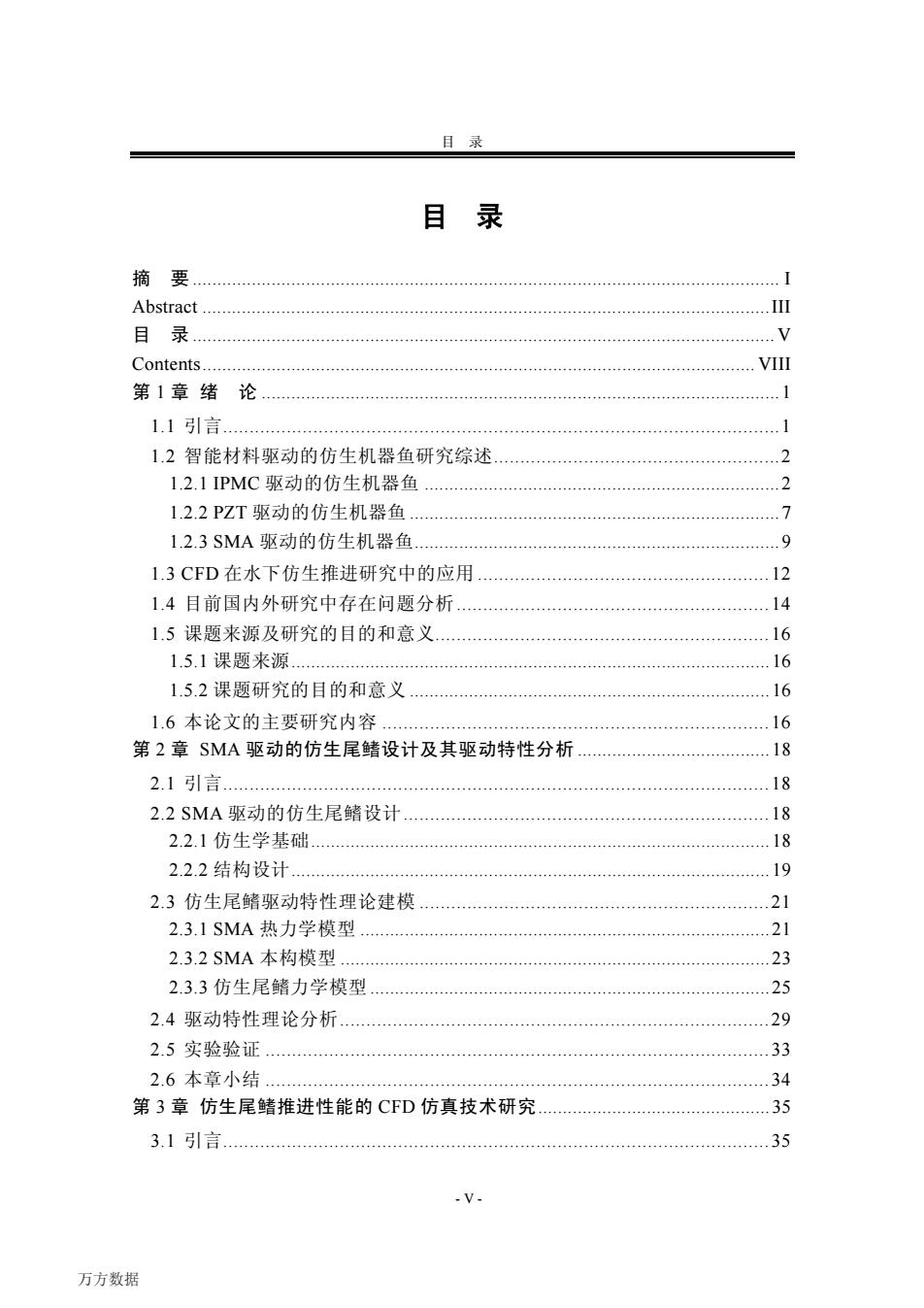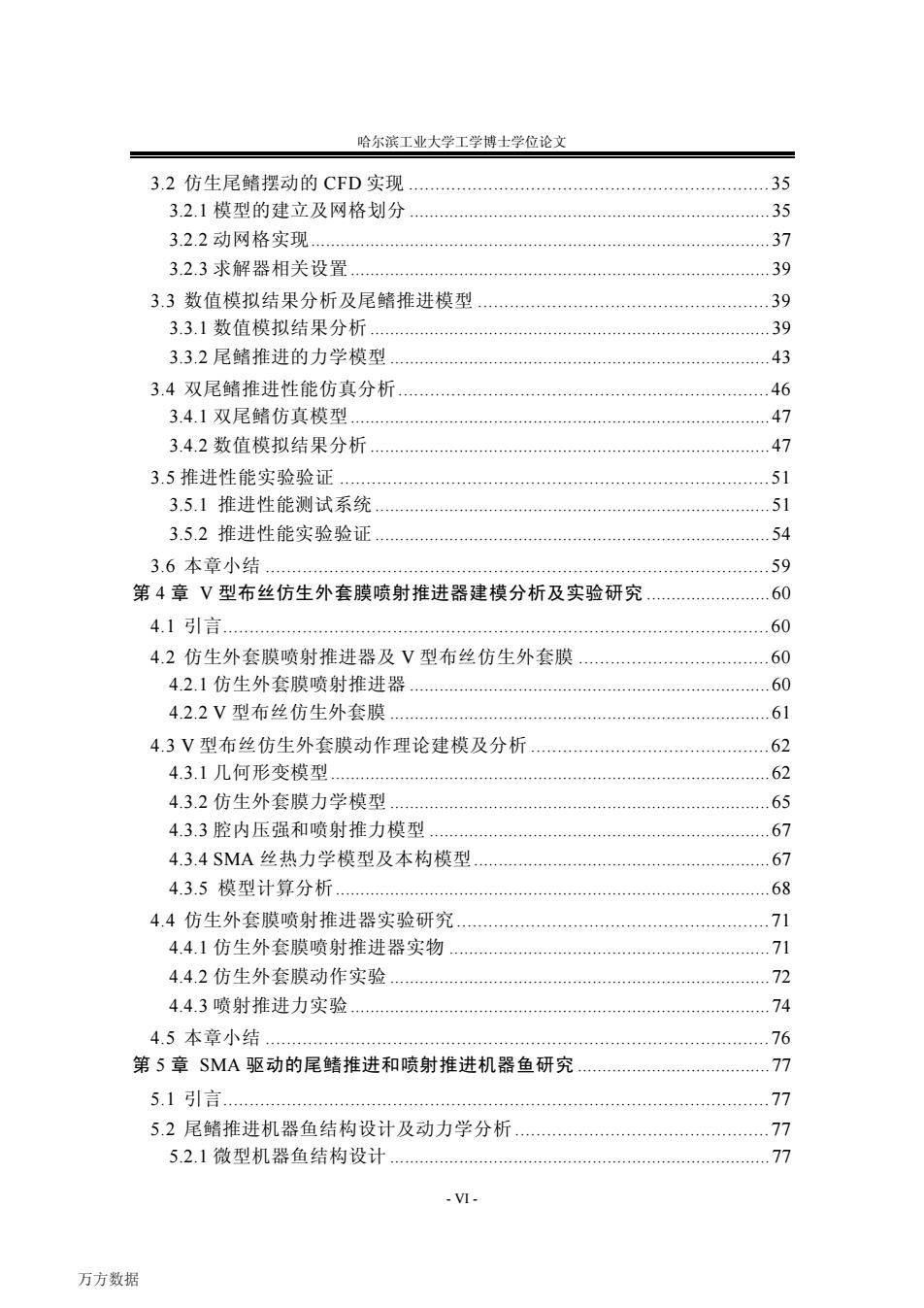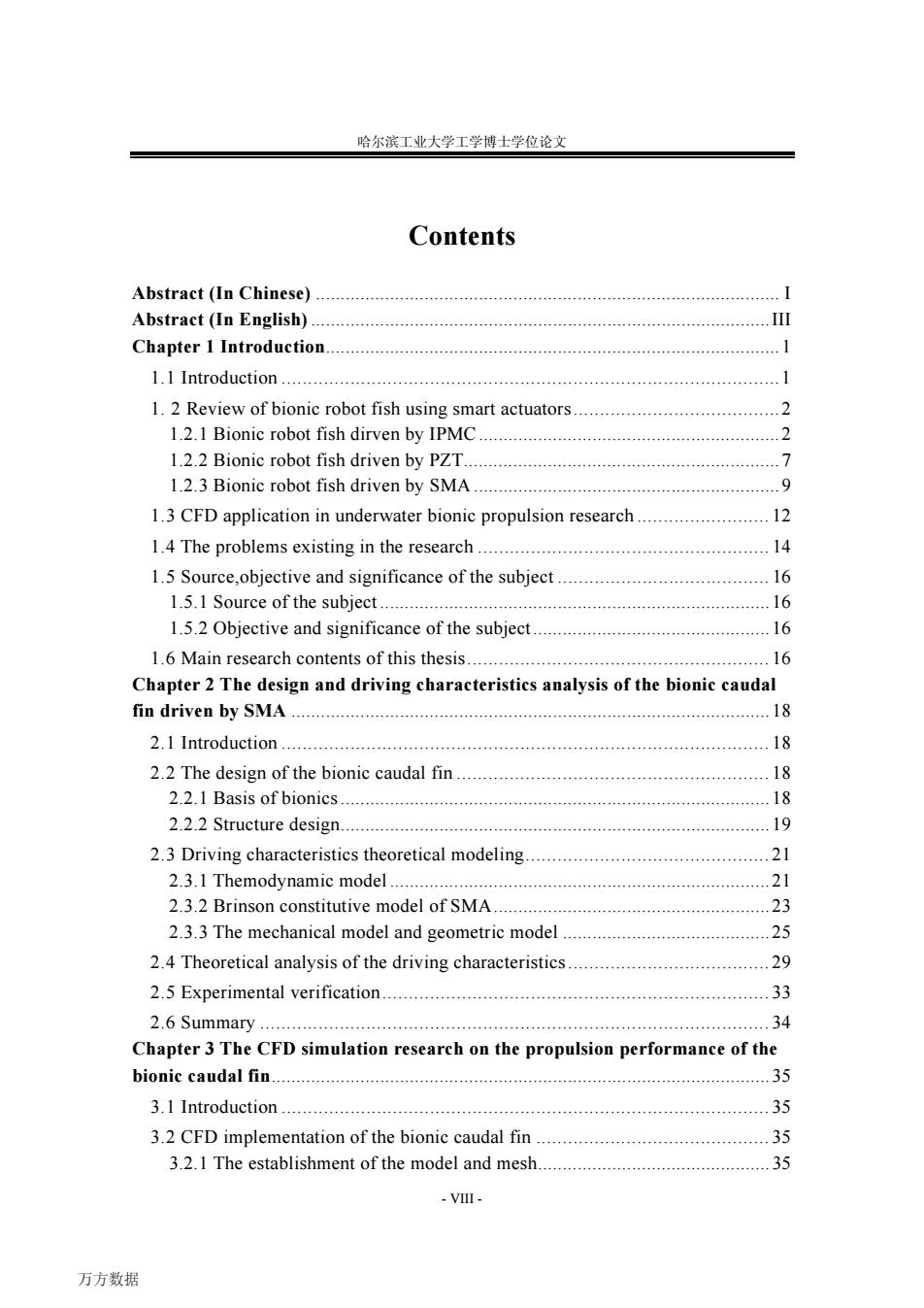
哈尔滨工业大学工学博士学位论文 effectively eliminate the fluctuation of the lateral force,but also enhance the propulsive force,which means that the propulsive force the twin caudal fin produced is greater than the sum of the propulsive force that two individual single caudal fin produced.In addition,the flow field,the pressure field and the three dimensional vorticity around the single and twin caudal fin were analyzed,and the propulsion mechanism of the caudal fin and the fluid field couple of the twin caudal fin were also analyzed.Subsequently,the propulsive force test platform was established and the propulsive force and lateral force that produce by the single caudal fin and the twin caudal fin were measured respectively.The experiment results verified the correctness of the numerical simulation. Based on the analysis of the mechanism of the cuttlefish jet propulsion,our research group developped a kind of bionic cuttlefish mantle actuated by SMA by imitating the structure of the cuttlefish mantle,through which the jet propulsion can be achieved.To further improve the action performance of the bionic mantle,we improve the arrangement of the SMA wire and put forwad a kind of bionic mantle with the V type arrangement of SMA wire.In order to anlyalze the action and propulsion performance of the V type arrangement bionic mantle,the action theory model has been established which combined the geometric deformable model,the mechanical model and the cavity pressure model of the bionc mantle and the thermodynamic model,constitutive model of SMA.Through the analysis of the model,the action amplitude of the bionic mante and the jet thrust the bionic mantle jet propeller can produce were cauculate and the impact of the SMA wire arrangement angle on the action amplitude were investigae,and the optimal SMA wire arrangement was obtained.Then the experimental study was conducted to reseach the jet thrust performane of the bionic mantle jet propeller and the results verified the correctness of the theory. Finally,a bionic robot fish based on the bionic caudal fin propulsion and a bionic robot fish based on the bionic jet propulsion were developed respectively,and a control system can realize the self-propelled swimming was also developed.Then the swimming experiment was carried out,the results show that the bionic fish can realize the straight line swimming,the turning swimming and desired trajectory self-propelled swimming.Furthermore,the experimental results also show that the twin caudal propulsion can effectively eliminate the head swinging and improve the stability of the robot fish. Keywords:SMA,bionic robot fish,tail fin propulsion,jet propulsion,propulsion performance,CFD simulation,autonomous swimming -IV. 万方数据
哈尔滨工业大学工学博士学位论文 - IV - effectively eliminate the fluctuation of the lateral force, but also enhance the propulsive force, which means that the propulsive force the twin caudal fin produced is greater than the sum of the propulsive force that two individual single caudal fin produced. In addition, the flow field, the pressure field and the three dimensional vorticity around the single and twin caudal fin were analyzed, and the propulsion mechanism of the caudal fin and the fluid field couple of the twin caudal fin were also analyzed. Subsequently, the propulsive force test platform was established and the propulsive force and lateral force that produce by the single caudal fin and the twin caudal fin were measured respectively. The experiment results verified the correctness of the numerical simulation. Based on the analysis of the mechanism of the cuttlefish jet propulsion, our research group developped a kind of bionic cuttlefish mantle actuated by SMA by imitating the structure of the cuttlefish mantle, through which the jet propulsion can be achieved. To further improve the action performance of the bionic mantle, we improve the arrangement of the SMA wire and put forwad a kind of bionic mantle with the V type arrangement of SMA wire. In order to anlyalze the action and propulsion performance of the V type arrangement bionic mantle, the action theory model has been established which combined the geometric deformable model, the mechanical model and the cavity pressure model of the bionc mantle and the thermodynamic model, constitutive model of SMA. Through the analysis of the model, the action amplitude of the bionic mante and the jet thrust the bionic mantle jet propeller can produce were cauculate and the impact of the SMA wire arrangement angle on the action amplitude were investigae, and the optimal SMA wire arrangement was obtained. Then the experimental study was conducted to reseach the jet thrust performane of the bionic mantle jet propeller and the results verified the correctness of the theory. Finally, a bionic robot fish based on the bionic caudal fin propulsion and a bionic robot fish based on the bionic jet propulsion were developed respectively, and a control system can realize the self-propelled swimming was also developed. Then the swimming experiment was carried out, the results show that the bionic fish can realize the straight line swimming, the turning swimming and desired trajectory self-propelled swimming. Furthermore, the experimental results also show that the twin caudal propulsion can effectively eliminate the head swinging and improve the stability of the robot fish. Keywords: SMA, bionic robot fish, tail fin propulsion, jet propulsion, propulsion performance, CFD simulation, autonomous swimming 万方数据

目录 目录 摘要 Abstract.… I 目录 N Contents...... VIII 第1章绪论 1.1引言. 1.2智能材料驱动的仿生机器鱼研究综述 .2 1.2.1IPMC驱动的仿生机器鱼 2 1.2.2PZT驱动的仿生机器鱼 7 1.2.3SMA驱动的仿生机器鱼 9 L.3CFD在水下仿生推进研究中的应用 12 1.4目前国内外研究中存在问题分析 14 1.5课题来源及研究的目的和意义 16 1.5.1课题来源 16 1.5.2课题研究的目的和意义 16 1.6本论文的主要研究内容 16 第2章SMA驱动的仿生尾鳍设计及其驱动特性分析 18 2.1引言… 18 2.2SMA驱动的仿生尾鳍设计 18 2.2.1仿生学基础 18 22.2结构设计 19 2.3仿生尾鳍驱动特性理论建模 21 2.3.1SMA热力学模型 21 2.3.2SMA本构模型 23 233仿生尾鳍力学模型 25 2.4驱动特性理论分析 29 2.5实验验证 33 2.6本章小结 34 第3章仿生尾鳍推进性能的CFD仿真技术研究 35 3.1引言. 35 -V. 万方数据
目 录 - V - 目 录 摘 要 ....................................................................................................................... I Abstract ...................................................................................................................III 目 录 ...................................................................................................................... V Contents................................................................................................................ VIII 第 1 章 绪 论 .........................................................................................................1 1.1 引言.........................................................................................................1 1.2 智能材料驱动的仿生机器鱼研究综述......................................................2 1.2.1 IPMC 驱动的仿生机器鱼 ........................................................................2 1.2.2 PZT 驱动的仿生机器鱼 ...........................................................................7 1.2.3 SMA 驱动的仿生机器鱼..........................................................................9 1.3 CFD 在水下仿生推进研究中的应用 .......................................................12 1.4 目前国内外研究中存在问题分析...........................................................14 1.5 课题来源及研究的目的和意义...............................................................16 1.5.1 课题来源.................................................................................................16 1.5.2 课题研究的目的和意义 .........................................................................16 1.6 本论文的主要研究内容 .........................................................................16 第 2 章 SMA 驱动的仿生尾鳍设计及其驱动特性分析 .......................................18 2.1 引言.......................................................................................................18 2.2 SMA 驱动的仿生尾鳍设计.....................................................................18 2.2.1 仿生学基础.............................................................................................18 2.2.2 结构设计.................................................................................................19 2.3 仿生尾鳍驱动特性理论建模 ..................................................................21 2.3.1 SMA 热力学模型 ...................................................................................21 2.3.2 SMA 本构模型 .......................................................................................23 2.3.3 仿生尾鳍力学模型 .................................................................................25 2.4 驱动特性理论分析.................................................................................29 2.5 实验验证 ...............................................................................................33 2.6 本章小结 ...............................................................................................34 第 3 章 仿生尾鳍推进性能的 CFD 仿真技术研究...............................................35 3.1 引言.......................................................................................................35 万方数据

哈尔滨工业大学工学博士学位论文 3.2仿生尾鳍摆动的CFD实现 35 3.2.1模型的建立及网格划分 35 3.2.2动网格实现 37 3.2.3求解器相关设置 39 3.3数值模拟结果分析及尾鳍推进模型 39 3.3.1数值模拟结果分析 39 3.3.2尾鳍推进的力学模型 43 3.4双尾鳍推进性能仿真分析 。。。。。。。 46 3.4.1双尾鳍仿真模型 47 3.4.2数值模拟结果分析. 47 3.5推进性能实验验证 51 3.5.1推进性能测试系统 51 3.5.2推进性能实验验证… 54 3.6本章小结 59 第4章V型布丝仿生外套膜喷射推进器建模分析及实验研究… 60 4.1引言… 60 4.2仿生外套膜喷射推进器及V型布丝仿生外套膜 60 4.2.1仿生外套膜喷射推进器 60 4.2.2V型布丝仿生外套膜 61 4.3V型布丝仿生外套膜动作理论建模及分析 62 4.3.1几何形变模型 62 4.3.2仿生外套膜力学模型 65 4.3.3腔内压强和喷射推力模型 67 4.3.4SMA丝热力学模型及本构模型 67 4.3.5模型计算分析… 68 4.4仿生外套膜喷射推进器实验研究 71 4.4.1仿生外套膜喷射推进器实物 71 4.4.2仿生外套膜动作实验 72 4.4.3喷射推进力实验 74 4.5本章小结.… 76 第5章SMA驱动的尾鳍推进和喷射推进机器鱼研究 77 5.1引言.. 77 5.2尾鳍推进机器鱼结构设计及动力学分析 77 5.2.1微型机器鱼结构设计..… 77 -VI. 万方数据
哈尔滨工业大学工学博士学位论文 - VI - 3.2 仿生尾鳍摆动的 CFD 实现 ....................................................................35 3.2.1 模型的建立及网格划分 .........................................................................35 3.2.2 动网格实现.............................................................................................37 3.2.3 求解器相关设置.....................................................................................39 3.3 数值模拟结果分析及尾鳍推进模型 .......................................................39 3.3.1 数值模拟结果分析 .................................................................................39 3.3.2 尾鳍推进的力学模型 .............................................................................43 3.4 双尾鳍推进性能仿真分析......................................................................46 3.4.1 双尾鳍仿真模型.....................................................................................47 3.4.2 数值模拟结果分析 .................................................................................47 3.5 推进性能实验验证 .................................................................................51 3.5.1 推进性能测试系统 ................................................................................51 3.5.2 推进性能实验验证 ................................................................................54 3.6 本章小结 ...............................................................................................59 第 4 章 V 型布丝仿生外套膜喷射推进器建模分析及实验研究 .........................60 4.1 引言.......................................................................................................60 4.2 仿生外套膜喷射推进器及 V 型布丝仿生外套膜 ....................................60 4.2.1 仿生外套膜喷射推进器 .........................................................................60 4.2.2 V 型布丝仿生外套膜 .............................................................................61 4.3 V 型布丝仿生外套膜动作理论建模及分析 .............................................62 4.3.1 几何形变模型.........................................................................................62 4.3.2 仿生外套膜力学模型 .............................................................................65 4.3.3 腔内压强和喷射推力模型 .....................................................................67 4.3.4 SMA 丝热力学模型及本构模型............................................................67 4.3.5 模型计算分析........................................................................................68 4.4 仿生外套膜喷射推进器实验研究...........................................................71 4.4.1 仿生外套膜喷射推进器实物 .................................................................71 4.4.2 仿生外套膜动作实验 .............................................................................72 4.4.3 喷射推进力实验.....................................................................................74 4.5 本章小结 ...............................................................................................76 第 5 章 SMA 驱动的尾鳍推进和喷射推进机器鱼研究 .......................................77 5.1 引言.......................................................................................................77 5.2 尾鳍推进机器鱼结构设计及动力学分析 ................................................77 5.2.1 微型机器鱼结构设计 .............................................................................77 万方数据

目录 5.2.2机器鱼游动时的流体阻力模型 78 5.2.3机器鱼的二维动力学模型 。, 。。。。,。。。。。。。。。。。。。。, 80 5.2.4机器鱼动力学仿真分析 82 5.3机器鱼控制系统设计 85 5.3.1惯性导航原理及算法 85 5.3.2控制系统硬件设计 87 5.3.3控制系统软件设计 89 5.4仿生尾鳍推进机器鱼游动实验 91 5.4.1机器鱼实物 91 5.4.2直线游动实验 92 5.4.3转弯游动实验 96 5.4.4自主游动试验 97 5.5仿生墨鱼水下机器人喷射推进游动实验 99 5.5.1仿生墨鱼水下机器人 99 5.5.2喷射推进游动实验 99 5.6本章小结 102 结论. 103 参考文献 106 攻读博士学位期间发表的论文及其它成果 115 哈尔滨工业大学学位论文原创性声明及使用授权说明 .116 致谢 .117 个人简历… .119 万方数据
目 录 - VII - 5.2.2 机器鱼游动时的流体阻力模型 .............................................................78 5.2.3 机器鱼的二维动力学模型 .....................................................................80 5.2.4 机器鱼动力学仿真分析 .........................................................................82 5.3 机器鱼控制系统设计 .............................................................................85 5.3.1 惯性导航原理及算法 .............................................................................85 5.3.2 控制系统硬件设计 .................................................................................87 5.3.3 控制系统软件设计 .................................................................................89 5.4 仿生尾鳍推进机器鱼游动实验...............................................................91 5.4.1 机器鱼实物.............................................................................................91 5.4.2 直线游动实验.........................................................................................92 5.4.3 转弯游动实验.........................................................................................96 5.4.4 自主游动试验.........................................................................................97 5.5 仿生墨鱼水下机器人喷射推进游动实验 ................................................99 5.5.1 仿生墨鱼水下机器人 .............................................................................99 5.5.2 喷射推进游动实验 .................................................................................99 5.6 本章小结 .............................................................................................102 结 论 ...................................................................................................................103 参考文献 ...............................................................................................................106 攻读博士学位期间发表的论文及其它成果 ........................................................ 115 哈尔滨工业大学学位论文原创性声明及使用授权说明..................................... 116 致 谢 ................................................................................................................... 117 个人简历 ............................................................................................................... 119 万方数据

哈尔滨工业大学工学博士学位论文 Contents Abstract(In Chinese) Abstract(In English) I11 Chapter 1 Introduction .1 1.1 Introduction.… 1 1.2 Review of bionic robot fish using smart actuators.......................... 2 1.2.1 Bionic robot fish dirven by IPMC .2 1.2.2 Bionic robot fish driven by PZT........................... 7 1.2.3 Bionic robot fish driven by SMA 9 1.3 CFD application in underwater bionic propulsion research 12 1.4 The problems existing in the research.............. 14 1.5 Source,objective and significance of the subject.................. 16 1.5.I Source of the subject. 16 1.5.2 Objective and significance of the subject....................... 16 1.6 Main research contents of this thesis.......... 16 Chapter 2 The design and driving characteristics analysis of the bionic caudal fin driven by SMA 18 2.1 Introduction........... 18 2.2 The design of the bionic caudal fin. 18 2.2.1 Basis of bionics.. 18 2.2.2 Structure design................. 19 2.3 Driving characteristics theoretical modeling 21 2.3.1 Themodynamic model.......... 21 2.3.2 Brinson constitutive model of SMA...... 23 2.3.3 The mechanical model and geometric model ................................. 25 2.4 Theoretical analysis of the driving characteristics 29 2.5 Experimental verification.. 33 2.6 Summary........ 34 Chapter 3 The CFD simulation research on the propulsion performance of the bionic caudal fin 35 3.1 Introduction.... 35 3.2 CFD implementation of the bionic caudal fin 35 3.2.1 The establishment of the model and mesh......................... .35 -vIlI- 万方数据
哈尔滨工业大学工学博士学位论文 - VIII - Contents Abstract (In Chinese) .............................................................................................. I Abstract (In English) .............................................................................................III Chapter 1 Introduction............................................................................................1 1.1 Introduction ..............................................................................................1 1. 2 Review of bionic robot fish using smart actuators.......................................2 1.2.1 Bionic robot fish dirven by IPMC.............................................................2 1.2.2 Bionic robot fish driven by PZT................................................................7 1.2.3 Bionic robot fish driven by SMA ..............................................................9 1.3 CFD application in underwater bionic propulsion research ......................... 12 1.4 The problems existing in the research ....................................................... 14 1.5 Source,objective and significance of the subject ........................................ 16 1.5.1 Source of the subject ...............................................................................16 1.5.2 Objective and significance of the subject................................................16 1.6 Main research contents of this thesis......................................................... 16 Chapter 2 The design and driving characteristics analysis of the bionic caudal fin driven by SMA .................................................................................................18 2.1 Introduction ............................................................................................ 18 2.2 The design of the bionic caudal fin ........................................................... 18 2.2.1 Basis of bionics .......................................................................................18 2.2.2 Structure design.......................................................................................19 2.3 Driving characteristics theoretical modeling.............................................. 21 2.3.1 Themodynamic model .............................................................................21 2.3.2 Brinson constitutive model of SMA........................................................23 2.3.3 The mechanical model and geometric model ..........................................25 2.4 Theoretical analysis of the driving characteristics ...................................... 29 2.5 Experimental verification......................................................................... 33 2.6 Summary ................................................................................................ 34 Chapter 3 The CFD simulation research on the propulsion performance of the bionic caudal fin.....................................................................................................35 3.1 Introduction ............................................................................................ 35 3.2 CFD implementation of the bionic caudal fin ............................................ 35 3.2.1 The establishment of the model and mesh...............................................35 万方数据